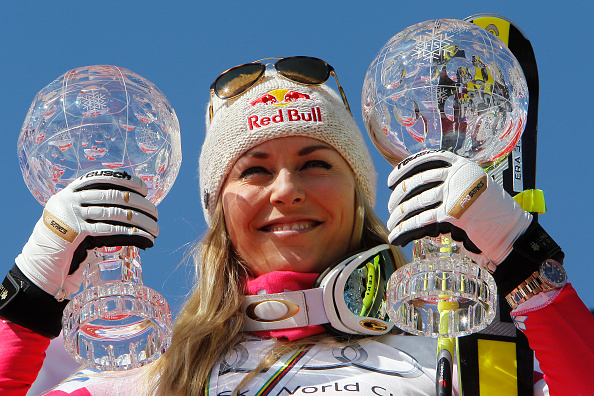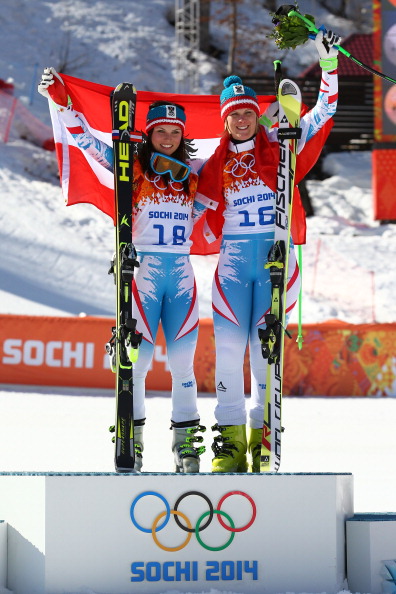It was long ago the case that Lindsey Vonn became the best alpine skier the United States ever produced. Now, as this season’s racing draws to a close, with Vonn on a not-really-100 percent right knee, she has written a fascinating first next chapter to the ongoing story that is her singular career.
The day after clinching this season’s World Cup downhill title, Vonn won the super-G crystal globe, too. In all, she now has 19 globes, the same as Swedish great Ingemar Stenmark.
“I am honored to even be in the same sentence as him,” she said afterward in Meribel, France.
Vonn won the super-G title after finishing Thursday’s race 49-hundredths of a second ahead of Austria’s Anna Fenninger.
Fenninger, racing with bib 15, had come down into first place with a time of 1:08.19.
Vonn raced 19th. By the second interval, it was clear she was on her game, up 41-hundredths. By the finish line, after navigating a tricky jump, the margin was up to that 49-hundredths.
The downhill win Wednesday was Vonn’s 66th career victory, the super-G her 67th. Stenmark has 86. Vonn’s plan is to race through the 2018 season, and the Winter Games in South Korea.
Vonn also said, “It’s nice to know I can still win titles,” particularly when there were so many doubters this season, and of course there were.
Vonn blew out the right knee in a super-G at the 2013 world championships in Schladming, Austria. Trying to make the Sochi Olympics, she hurt the same knee again; she did not ski in the 2014 Games.
By the time she came back to the tour, as she recounted Thursday, she had maybe five days of downhill training, perhaps 20 days of training overall.
There were doubters, but only because those who doubt don’t understand that even when Lindsey Vonn is not 100 percent physically right she is 110 percent mentally tough.
She belongs to a special category of athlete.
It is always risky to go here, to say that so-and-so is different from someone — or everyone — else.
But the evidence is irrefutable.
Vonn’s knee is still not, well, right. You saw it at the world championships last month in Beaver Creek, Colorado, when the course was ridiculously hard and icy, and — for her — she struggled, managing “only” to win one medal, a bronze in the super-G.
She alluded to that Thursday, saying that she now will have all summer to get stronger and that the spring snow conditions in Europe the past couple weeks have been easier on her body:
“The soft snow is really nice. It’s really forgiving on my knee. It feels good. It haven’t had any problems since Beaver Creek. It’s only when it’s icy that I run into problems.”
Where you really heard her open up, meanwhile, is in the way she talked about attacking the course in the way that many racers say they do but she actually then does consistently:
“I am going to risk it all every time I am in the starting gate. That is what makes me fast.”
This is why Lindsey Vonn is the greatest of all time. In response to a question Thursday about whether she was still as fearless as she was before wrecking her knee, she said, yes, and that some of her “poor results” this year were because she “risked too much” or didn’t ski with “the same strength and power.”
She is self-reflective enough to know what can be seen at the bottom of the hill, too: her super-G is probably better now but her downhill, even for her, can be better. “I’m not building pressure at the top of the turn like I can,” she said of her downhilling.
All that, obviously, can and will change with a full summer of training.
What’s also going to change is that she is going to get even better — tougher still — mentally.
The best athletes do this, and she will.
She said Thursday that chasing records has been one of her faults.
Everyone in ski circles, especially Vonn, knew that Austria’s Annemarie Moser-Pröll held the record for most World Cup wins by a female racer, 62, until Vonn broke it earlier this season.
Now Vonn is being asked about 86. The math says that if she keeps winning eight races per season, like she did this year, it’s a done deal.
But. as she said on a call with reporters, “”That’s a lot easier said than done,” adding, “I don’t really look at that as a goal right now. My goal is to keep winning races and keep getting as many titles as I can.”
Her mom, Linda, was on that call, and said at the end of it, “It seems like old times, Lindsey.”
Yes, but there’s a lot more yet to be written.
“I’ll call you later,” Lindsey said to her mom. “I love you.”








